When I met Karen, she was earning $17,000 a year. Today, if you account for inflation, that would be about $45,000 a year. (See the nifty inflation calculator at the Bureau of Labor Statistics.)
Karen set aside enough money to buy a rental condominium at Port Hueneme, California, and a vacant lot with a magnificent view at the top of a bluff above Laguna Beach. Her retirement account at work was maxed out, with savings set aside. That was before IRAs were available to people covered by employer retirement plans. Karen’s only incentive? Saving for a secure financial future.
Do You Really Need External Incentives to Save?
It isn’t that tough to save, once you start. The best thing you can do is to simply develop good saving habits.
Rita Veen, an enrolled agent in Castaic, California, encourages her clients to set aside $25 a week. You can invest those savings by buying a single share of a corporation’s stock and reinvesting the dividends. She also recommends subscribing to The Moneypaper. The calculator on its front page shows that investing $100 a month for 50 years would result in nearly $1.75 million by the time you’re ready to retire.
OK, You Need Government Incentives to Keep You Saving
If you’ll only save because the government gives you an incentive, here’s a list of incentives that individuals control, with the annual contribution limit per person. In parentheses is the contribution limit for folks age fifty or over. (Note that employers can offer more options.)
- Deductible IRA: $5,000 ($6,000). Savings grow tax-free and are taxed at retirement.
- Nondeductible IRA: $5,000 ($6,000). Savings grow tax-free and are taxed at retirement. Track your contributions-you get them back tax-free.
- Roth IRA: $5,000 ($6,000). Savings grow tax-free and are not taxed at retirement.
- Coverdell Education Savings Account (ESA): $2,000. Savings grow tax-free. Draws are not taxed if funds are used for education. Anyone may fund the account (parents, grandparents, employers, friends, etc.).
- Qualified Tuition Program (or Section 529 Plan): Maximum annual contributions equal to the gift tax exclusion limit ($13,000 in 2010), or a onetime contribution of up to $65,000. Contributions may restart after the fifth year. Earnings grow tax-free. Draws are not taxed if used for education. Investment options are limited.
- Retirement Savings Contribution Credit: $1,000 credit per saver for contributions to IRAs or qualified employee retirement plans.
- Homes: Sell a home every two years without paying taxes on up to $250,000 of profit ($500,000 if married filing jointly).
- Capital Gains Tax Rate: In 2010, you may sell your stocks or assets and pay as little as 0 percent tax on the profit-or no more than 15 percent. Cash in on profits and reinvest in something with a better future.
Savings Incentives are Helpful, But Watch Out
Be aware that all these investment options have limitations based on your income level, or if you’re covered by a retirement plan at work. There are penalties for early withdrawal, ranging from 10 percent to 25 percent, plus state penalties. Of course, there are ways to avoid the penalties. And there are special incentives for people in the military and people who live in certain disaster areas.
Before investing in or drawing money from these savings plans, consult with your tax professionals. They can help you work out the best tax advantage for what you’re trying to do. Whatever you do, don’t count on the government to take care of you in your old age. Taking responsibility for yourself ensures a much happier life-and a better retirement.
Eva Rosenberg, EA is the publisher of TaxMama.com, where your tax questions are answered. Eva is the author of several books and ebooks, including Small Business Taxes Made Easy. Eva teaches a tax pro course at IRSExams.com.





